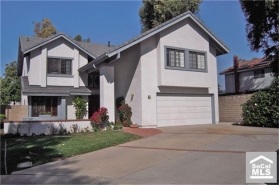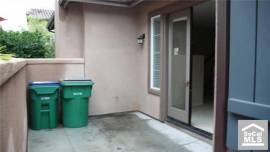Real estate sellers that can't get their asking price often consider renting the property and waiting for better days. Now even the federal government is considering holding some if its property purchased as REO through the GSEs. Is that a good idea?


Irvine Home Address … 1 West FORTUNA Irvine, CA 92620
Resale Home Price …… $669,000

I've had choices
Since the day that I was born
There were voices
That told me right from wrong
If I had listened
No I wouldn't be here today
Living and dying
With the choices I made
George Jones — Choices
The government has choice to make with its REO. Based on past choices we have seen coming out of Washington, I suspect they will make the wrong choice, but with so much pressure to do the wrong thing, making the right choice is nearly impossible for most politicians.
Government Weighs Turning Foreclosures Into Rentals
By Nick Timiraos — July 22, 2011, 11:28 AM ET
There’s an 800-pound gorilla in the nation’s hardest-hit housing markets: hundreds of thousands of foreclosed properties are selling, and there’s four times as many potential foreclosures behind them.
The Journal writes today that one idea gaining support in Washington is an effort to pull some of those properties off the market and rent them out, either on homes owned by federal agencies or loan giants Fannie Mae and Freddie Mac.
Ordinarily, I would be appalled by this idea. Keeping houses off the market in order to keep prices too high for families to afford is abominable, particularly for the government which is supposed to help facilitate affordable housing. However, in many markets, prices are not too high for families to afford. In Las Vegas, two minimum wage workers can combine incomes to purchase a single-family detached house. Affordability is not a barrier to anyone in Las Vegas. Prices do not need to be lower there to attract families or investors.
In markets like Las Vegas, withholding inventory from the for-sale market and renting them out makes sense. In fact, in any housing market where the cost of ownership is 30% or more less than the cost of rental, these houses should be rented rather than sold. Whenever the cost of ownership and the cost of rental gets out of balance, the market is sending a signal. When owning is significantly less expensive than renting, the market is telling participants to buy. However, in Las Vegas, most of the potential buyer pool just went through foreclosure and can't buy. Therefore the imbalance between the cost of owning and the cost of renting gets worse. Under those conditions, the market is demanding more rentals.
These firms and U.S. banks currently own more than 500,000 foreclosed homes, and there’s another 2 million loans in some stage of foreclosure. The high share of distressed sales in many struggling markets is contributing to continued declines in home prices.
“Can we find a way to try and reduce that overhang or to try to provide incentives for investors to covert them?” said Federal Reserve Chairman Ben Bernanke in testimony to Congress last week.
Ben Bernanke is suggesting providing incentives for investors? I suggested the same thing last year in the post Should Government Mortgage Subsidies Be Offered to Cashflow Investors?, and I was lambasted. My argument was simple: “In housing markets where a significant number of properties are being converted from owner-occupied to rental status, there is no government program or help for this transition to occur. Without government help, prices fall far below fundamental valuations as the imbalance of supply and demand becomes extreme. The only solution is to reduce supply and increase demand. To accomplish this, I propose that the GSEs promote investor programs that reduce the cost of ownership to small investors and encourage them to keep the supply off the resale market.“
Nine months later, and Washington has finally caught up with my ideas.
Critics worry about the risk of the government as landlord. One solution: sell federally backed foreclosures to investors who would have to agree to rent them out for a to-be-determined period of time. Investors would rehab the properties, fill them with tenants, and hire a national property management firm to oversee the day-to-day landlord needs.
Supporters say while the government isn’t set up to be a landlord, neither is it any better prepared to sell thousands of foreclosed properties — something it’s already doing anyway. “Putting these homes in the hands of people who can take care of them and rent them out” would save taxpayer money, says John Burns, who runs a home-building consulting firm in Irvine, Calif.
John Burns is right. We really don't need the government to be involved in this. Real estate cashflow investors will stabilize the housing market all on their own. As I noted in that post: “The best solution does not require a subsidy. Merely eliminate the limit on the number of mortgages a cashflow investor may have, and count 75% of the rental income toward the payment. Eliminating the limit on the number of mortgages costs no money, and it allows those investors with expertise in obtaining and managing properties the ability to acquire more. By counting a portion of the rental income toward qualification, wherever the prices are low enough for cashflow investors to make a profit will quickly get bid up to the limit of available financing.
None of this costs the government anything, and the demand it creates is not artificial based on a financial subsidy that inflates prices. The GSEs are merely eliminating an artificial barrier they created. This demand would seek out the most downtrodden markets and put a floor beneath prices in those areas. Very little of that money would flow into inflated markets like Orange County because so few properties meet the criteria.”
So far, the Fannie and Freddie have disappointed institutional investors by resisting selling homes in bulk at deep discounts. Instead, foreclosures are either sold through regular retail listings or in public auctions, known as trustee or sheriff sales. Those auctions have attracted primarily mom-and-pop investors but also include hedge fund-backed debt buyers.
I hope the GSEs continue to resist giving away properties to institutional investors. Selling to small investors will increase their recovery significantly, and I don't want the competition.
Two years ago, investors increasingly scooped up cheap properties at auctions in the hopes of rehabbing and quickly reselling them for a profit. But declining home values — and increased competition from investors — has made that much harder.
The margins at auction are in decline. In fact, over the last month or so, there has been far too much money chasing too few properties. Lenders have been pushing fewer properties through the auction sites because they are oversaturating the MLS, but the lure of easy money has drawn dumb money to the auction site where prices are being bid up to near retail levels on some properties. Auction markets have ebbs and flows, but the increasing competition has reached a point where many will overpay and lose money never to return.
Meanwhile, the discounts for foreclosed properties in some markets are so attractive “that it looks like the cash flow investors are getting [on rentals] is awfully good,” says Thomas Lawler, an independent housing economist in Leesburg, Va.
One sign that investor demand has picked up for cheap properties that can be rented: in Phoenix, the number of homes selling below $100,000 was up 41% from one year ago in May, while all other sales were down 11.3%, according to DataQuick, a real-estate data firm.
“It doesn’t take too long as an investor to recognize the opportunity: home prices are less, but rents are more,” says Eric Peterson, a former homebuilder and co-founder of Praxis Capital, which has launched a $10 million fund focused on renting out foreclosures. Once prices stabilize and begin rising in a few years, “we’ll be holding a fair amount of inventory, and we’ll be ready to sell.”
The idea has won backing from a number of influential private sector minds. Rental programs could “solve a couple of policy problems with one solution” by also extending qualified tenants an option to one day purchase the homes, said mortgage-bond pioneer Lewis Ranieri in a recent paper with Kenneth Rosen, a housing economist at the University of California at Berkeley.
So where should smart investors look for these rental home deals?
Best cities to invest in rental homes
In Las Vegas, investors willing to take a gamble could win big
Amy Hoak — July 11, 2011, 5:53 p.m. EDT 
HomeVestors of America and Local Market Monitor released its list of best markets to invest in rental property, and Las Vegas came out on top. HomeVestors is a real-estate investment company; Local Market Monitor is a forecaster of real-estate markets. Read more: Why investing in rentals could be a good move.
In Las Vegas, home prices are down 45% since their peak in 2006, according to the news release from the companies. Even better for investors: Many people who work in the casino industry are renters.
That means investors can buy homes at low prices and have a sizable pool of renters from which to choose.
Unemployment is a problem in Las Vegas, and rental vacancies are also a problem. Personally, I won't buy any properties with less than a $950 monthly rent, and I won't buy condos. Lower priced condos compete with the apartment complexes which offer better amenities. If and investor has a $1,100 a month single-family detached home, she can always lower the rent $50 to $100 and find a suitable renter. If an investor has a $700 per month condo, lowering the rent will not guarantee finding a renter. For that reason, I only consider detached homes with rents over $950 per month.
“What we’re looking for is how do you rank, based on the return that you get on the rentals, counterbalanced with the risk and what the price is,” said David Hicks, the co-president of HomeVestors, the company whose slogan has long been, “We buy ugly houses.”
The return could be short-term (the cash flow attained by renting out the property), long-term (the appreciation of the property over time) or both, he said. The risks include future potential home-price drops in the market.
What makes Las Vegas a unique market is its potential for both immediate cashflow and long-term appreciation. The current cashflow is obvious, but the long-term appreciation potential is based on the idea that prices are far below their long-term trendline, and once the problems with both supply and demand caused by the housing bubble have worked through the system, prices will spring back up to their long-term trendline.
Affordability is like water in a pool, and lender supply is like pushing a basketball below the waterline. Once the pressure abates, the ball pops back up to the surface. In neighborhoods where prices are still inflated above the waterline, prices don't pop back up.

The report looked particularly at single-family home rentals; about 14% of single-family homes in the country are maintained as rental properties, according to the news release. Renting a single-family home can be especially attractive to families who have lost their homes to foreclosure, Hicks said. Once parents have had a backyard for their children to play in, they often don’t want to live in an apartment home, he said.
That is another reason I like single-family detached homes over condos.
Traditionally, HomeVestors franchisees buy only about 12% of houses with the intention of fixing them for rental. A greater percentage of homes are bought to renovate and sell right away, Hicks said.
But that’s changing, and more are looking for income properties, he said.
“We see a lot of investors stung by the stock market over the past few years,” and now they’re turning to real estate, Hicks said. “Even counting the past few years, if you take long-term investing in properties and land, the return on that is some of the best investments people have ever had.”
The calculations in the report assumed markets’ three-year home-price forecasts and gross rents to assign them a risk-return premium. Las Vegas had a 4.7% risk-return premium, relative to the national average; San Francisco, which ranks 100 on the list, had a -2.4% risk-return premium, according to the report. …
Orange County would probably perform similarly to San Francisco as prices remain elevated in both markets. Orange County has poor cashflow and poor long-term potential for appreciation based on its current valuation. One can argue Orange County will experience superior income growth and thereby it will have superior appreciation. That is possible. California kool aid certainly is tasty. I am in no hurry to deploy my money here.


Rental property fund
In the next few months, I will be forming a fund to buy-and-hold cashflow properties in Las Vegas. Now that I know the market and have the team in place to handle the workload, I am prepared to deliver properties. For those willing to take a gamble on Las Vegas, stay tuned.
Put to the bank at the peak
The owners of today's featured property owned it for longer than my records go back. Based on their property taxes, I have inferred they paid about $200,000 about 25 years ago. You would think the house would be paid off by now, but this is Irvine not Indianapolis.
In a perfectly timed refinance, this couple took out a $600,000 loan on 9/16/2006, and followed it with a $227,000 HELOC on 3/27/2007. If they maxed out the HELOC, they obtained full resale value without having to sell or leave their house.
——————————————————————————————————————————————-
This property is available for sale via the MLS.
Please contact Shevy Akason, #01836707
949.769.1599
sales@idealhomebrokers.com


Irvine House Address … 1 West FORTUNA Irvine, CA 92620
Resale House Price …… $669,000.jpg)
Beds: 5
Baths: 4
Sq. Ft.: 2750
$243/SF
Property Type: Residential, Single Family
Style: Two Level, Other
Year Built: 1977
Community: Northwood
County: Orange
MLS#: S664891
Source: SoCalMLS
Status: Active
On Redfin: 21 days
——————————————————————————
End of Cul De Sac, 5 bedrooms, boasting 2 master suites w/ Own Full Bath. This is a Great area for a large Family. Side to a Large Green Belt, has Extra Long Driveway, Custom Built-ins, Custom Oak Balusters & Handrails, Custom Molding, Ceiling Fans, Tile Floors, Spacious Kitchen w/ Newer Appliances & Pantry, Large Family Room w/ Entertainment Unit, Remodeled Fireplace & Custom Windows, Indoor Laundry, Private Backyard, Newer Title Roof, Walk to Award Winning Schools Including Northwood High, Walk to Great Association Amenities-Pools, Spa, Tennis courts, Clubhouse, Tot Lots, BBQ's. Close to Hicks Canyon Trail, Parks & shopping. Low Tax Rate, NO MELLO ROOS, LOW Association.
——————————————————————————————————————————————-![]()
Proprietary IHB commentary and analysis
Since this property is in a neighborhood with no Mello Roos and a low association fee, the current price makes this property at or below rental parity. I challenge anyone to find a comparable rental for less than $2,700.
Resale Home Price …… $669,000
House Purchase Price … $200,000
House Purchase Date …. 1/1/1986
Net Gain (Loss) ………. $428,860
Percent Change ………. 214.4%
Annual Appreciation … 4.8%
Cost of Home Ownership
————————————————-
$669,000 ………. Asking Price
$133,800 ………. 20% Down Conventional
4.48% …………… Mortgage Interest Rate
$535,200 ………. 30-Year Mortgage
$115,947 ………. Income Requirement
$2,705 ………. Monthly Mortgage Payment
$580 ………. Property Tax (@1.04%)
$0 ………. Special Taxes and Levies (Mello Roos)
$139 ………. Homeowners Insurance (@ 0.25%)
$0 ………. Private Mortgage Insurance
$83 ………. Homeowners Association Fees
============================================
$3,508 ………. Monthly Cash Outlays
-$451 ………. Tax Savings (% of Interest and Property Tax)
-$707 ………. Equity Hidden in Payment (Amortization)
$222 ………. Lost Income to Down Payment (net of taxes)
$104 ………. Maintenance and Replacement Reserves
============================================
$2,674 ………. Monthly Cost of Ownership
Cash Acquisition Demands
——————————————————————————
$6,690 ………. Furnishing and Move In @1%
$6,690 ………. Closing Costs @1%
$5,352 ………… Interest Points @1% of Loan
$133,800 ………. Down Payment
============================================
$152,532 ………. Total Cash Costs
$40,900 ………… Emergency Cash Reserves
============================================
$193,432 ………. Total Savings Needed
——————————————————————————————————————————————————-



.jpg)




.png)


































.png)










